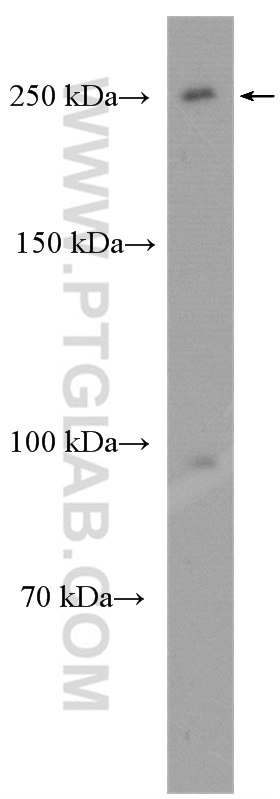验证数据展示
经过测试的应用
| Positive WB detected in | HEK-293 cells, HeLa cells |
推荐稀释比
| 应用 | 推荐稀释比 |
|---|---|
| Western Blot (WB) | WB : 1:500-1:1000 |
| It is recommended that this reagent should be titrated in each testing system to obtain optimal results. | |
| Sample-dependent, Check data in validation data gallery. | |
产品信息
22272-1-AP targets MDC1 in WB, ELISA applications and shows reactivity with human samples.
| 经测试应用 | WB, ELISA Application Description |
| 经测试反应性 | human |
| 免疫原 | Peptide 种属同源性预测 |
| 宿主/亚型 | Rabbit / IgG |
| 抗体类别 | Polyclonal |
| 产品类型 | Antibody |
| 全称 | mediator of DNA damage checkpoint 1 |
| 别名 | NFBD1, NFBD 1, MDC 1 |
| 计算分子量 | 227 kDa |
| 观测分子量 | ~260 kDa |
| GenBank蛋白编号 | NM_014641 |
| 基因名称 | MDC1 |
| Gene ID (NCBI) | 9656 |
| RRID | AB_3085691 |
| 偶联类型 | Unconjugated |
| 形式 | Liquid |
| 纯化方式 | Antigen affinity purification |
| UNIPROT ID | Q14676 |
| 储存缓冲液 | PBS with 0.02% sodium azide and 50% glycerol pH 7.3. |
| 储存条件 | Store at -20°C. Stable for one year after shipment. Aliquoting is unnecessary for -20oC storage. |
背景介绍
MDC1, also named as KIAA0170 or NFBD1, is a 2089 amino acid protein, which contains two BRCT domains and one FHA domain. MDC1 localizes in the nucleus and is highly expressed in testis. MDC1 is required for checkpoint mediated cell cycle arrest in response to DNA damage within both the S phase and G2/M phases of the cell cycle. MDC1 may serve as a scaffold for the recruitment of DNA repair and signal transduction proteins to discrete foci of DNA damage marked.
实验方案
| Product Specific Protocols | |
|---|---|
| WB protocol for MDC1 antibody 22272-1-AP | Download protocol |
| Standard Protocols | |
|---|---|
| Click here to view our Standard Protocols |

